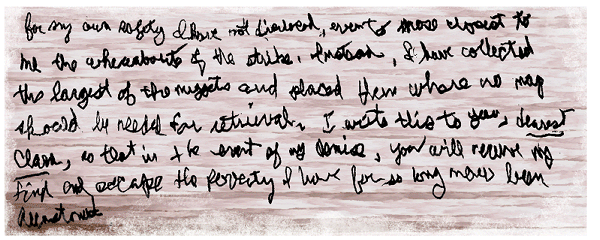-
Posts
6975 -
Joined
-
Last visited
-
Days Won
66
Content Type
Profiles
Forums
Events
Gallery
Blogs
Everything posted by bonanova
-
In between, for any angle other than 0 or 90 degrees, it's 360 degree [full rotational] symmetry. Or no symmetry; since every object reappears unchanged after 360 degree rotation.
-
I'm not sure what has to be ignored here, but you seem only to explicitly exclude stars.
-
Y/w. It is a great place. You have a pleasant, persuasive way of making a case. A rarity.
-
Yes that's the answer also given by armcie. There is a beautiful proof using complex numbers and a messier one just using [x, y]'s and angles and distances. I'll leave these as an extension to the puzzle. For now, here's an image that shows how, unexpectedly, Bud's "verbal map" was a great one. No map, no cabin, no distances, just the cairns - and the algorithm for using them.
-
If the ant does move relative to the band, then: The ant starts out 10" from the far end of the rubber band. Both the ant and the far end move forward at [whatever speed, they are equal]. The ant never gets to the end - their separation is forever 10" Seriously though, How can the ant's feet be attached to the rubber band and its motion be relative to something other than the rubber band? Is the ant flying at 1"/second? Is the ant, instead, walking on the ground, next to the rubber band? Or was that a typo?
-
The OP for that thread says, They have two kids, one of them is a girl, what is the probability that the other kid is also a girl. If the OP is taken as the "honest reporter" then we assume the unwritten rule and come up with 1/2. But there has to be a way, of laying out facts, that implicitly says "this is a complete specification - no other assumptions are warranted - answer, based just on what is stated." Otherwise you could never describe a general population from which one segment has been removed while leaving the others intact. I mean, saying there are three families - none of which has two boys but two [and only two] of which have the two cases of mixed gender. What is the probability of a family with two girls? There you have, unequivocally, 1/3. But it wouldn't be much of a riddle. My approach to solving puzzles is to take the OP as a complete specification of fact, from which a unique answer [if it's well worded] will arise. So my personal answer for that puzzle [since it lacks an honest reporter clause] is 1/3 - general population minus the boy-boy cases. Note that in the present thread [dice] I include a statement by the magician. "I have looked at your dice [after the fact] and I can tell you one of them is a six" [or paraphrase of that] Not to disagree with the analytical method just discussed - just to say that's how I view what a puzzle specification [rightly] is. For me, the other thread's OP would have to have included a statement like: "we are told by the father that one of his children is a girl" in order for me to invoke the rule. I would guess, from the volume of debate in that thread, that's where the majority of differences arose. Thanks for the light you've shed on this discussion. - bn
-
The cabin is long gone; and its former whereabouts are not known with enough precision, now, to be helpful. Bud obviously intended for Clara to retrace his steps starting from the porch. Andy's problem is that the starting point is no longer available to him, and that the distances were erased. We can assume Bud erased them for security reasons at some point, not because they were irrelevant. Alex had another idea.
-
Yes, Y and Z are the same number, as implied by "another" in the text.
-
I called Alex, and he said that's not it ...
-
The conclusion reached here is that there are two cases that apply to the added information: something is true; and we are told something is true. Case [1] facts are present that depict everything that can be said about a situation [for want of a better way to say it] We construct the population of equally likely cases, remove the impossible ones, and divide the favorables by the total. Thus, Of the population of 2-children families from which those with two boys have been removed, girl-girl families make up 1/3 Two fair dice have been rolled, repeatedly, until it is true that the number six is absent from the pair of numbers obtained. Removing from 36 outcomes the 25 where no six is seen, we note that [only] 1-6 and 6-1 -- 2 cases out of 11 -- total 7. But see how [any why] that changes in the 2nd case. Case [2] an honest observer looks at a particular outcome and gives us a partial picture of it. It may take an irritating paradox to force an intuitive thinker to see that [and how] this case differs from Case [1]. And it's not because we're not certain the observer has told the truth. It's rather that the truth he has told is only a partial picture, and we have to wonder about the part that was not said. What we've been told has been filtered, in a manner unknown to us, by the reporter. Thus we cannot be certain of the result [analyze the complete picture] unless [1] we are told what the observer's filter is or [2] we make the [unwritten rule] assumption the statement has been chosen at random from all of the similar statements that could also be true. A family with two children is said to have at least one girl. Certainly the boy-boy cases have been eliminated. But if what's left gives a 1/3 probability of girl-girl, we have to wonder whether the observer could have told us there was at least one boy. In 2/3 of the cases, we reason, that statement is also true. And if he had, we would have 1/3 boy-boy. Combined, both girl-girl and boy-boy cases would be eliminated, dictating a mixed-gender outcome. Separately, the statements leave us partially in the dark. Constructing tables [like table 1 in my previous post] leads to a paradox. If you are told one of two dice you rolled is a 6, how many outcomes are possible? 11; two of which total 7. But the symmetry of rolling a 7 [all numbers participate on an equally likely basis] demands six [equal] answers that total unity - i.e. 1/6. Either being told at least one die is a 6 is meaningless, or the probability must be calculated in a different way. Exploring the matter as I did in previous post, the problem is seen to arise from the overlap of cases permitted by the six statements. There is no overlap when the first die, or the second die, or the lower die, or the greater die is described. And in each of those cases p[7] = 1/6. And because {1st die, 2nd die} and {greater die, lesser die} are exclusive, exhaustive and equally likely, their averages must give the result for {randomly chosen die} = 1/6. If we are told the {older, younger} child is a girl, then p[girl-girl] = p[mixed] = 1/2 These cases also are exclusive, exhaustive and equally likely. So here it is: if the child that is described in the statement "One of the children is a girl" is randomly chosen from {older, younger}, then p[girl-girl] and p[mixed] must be the statistical average [add them up and divide by 2] of those two cases. Similarly, If we are told the {older, younger} - child is a boy, then p[boy-boy] = p[mixed] = 1/2 If we are told about a child who is a random choice of the two, the probabilities must be the same. But if our intuition still screams out that p[mixed] = 1/2 of the general population, so it therefore must be greater than 1/2 of any reduced population, Then we need further help to see how p[mixed] is affected by statements like these. In the unconstrained case, p[mixed] = p[girl-boy] + p[boy-girl] = 1/2 Why does it remain 1/2 when we are told something about [A] the older child: because p[mixed] is now calculated given the older child is girl. (B) the younger child: because p[mixed] is now calculated given the younger child is girl. [C] a random selection of {older child, younger child}: what is p[mixed] in this case? Here's the answer: [A] p[mixed] = p[girl-boy] = p[girl-girl] = 1/2 - these are the only two cases when older child is girl (B) p[mixed] = p[boy-girl] = p[girl-girl] = 1/2 - these are the only two cases when younger child is girl [C] p[mixed] = average of [A] and (B) = 1/2 As with the dice - which is the topic of this thread - only when the observer is biased in his choice of which die [or child] to talk about, does the "modified general population" analysis apply: "This statement is true [about a child or die] AND it's all that I will tell you. If it weren't true, you can be assured I would have said nothing."
-
Andy's great-grandfather Bud was a '49er who rode west in the California gold rush. He never struck it rich, but lived and died in poverty in Coloma, near Sutter's original mill - a place Andy had visited many times. All this had been handed down as rich family tradition. But today when Andy opened the shoebox of old heirlooms, all of that changed. There lay a letter written by Bud to his wife Clara. And it told a different story. Andy's heart began to race as he read ... Quickly Andy's eyes darted to great-grandpa Bud's verbal treasure map. The distances to the cairns had been erased! Perhaps Bud feared his letter would fall into the hands of thieves. But what good, then, to mail it? Andy knew approximately where the old cabin had stood, near the South Fork of the American River, and he decided, blurred information or not, it was worth another trip. The place had changed. Only a worn trail was left, and a young forest where once had laid an open plain. The stakes placed by Bud are surely gone, thought Andy, but possibly the cairns still stand. And after a short morning search, Andy found the cairns. But what next? Sipping coffee in the Wagon Wheel Cafe that noon, Andy sketched out what he knew. From his cabin, now gone, Bud had walked unknown, possibly different, distances and built cairns. Turning left at one, and right at the other, Bud duplicated the original distances and driven stakes into the ground. Midway between the stakes, also now gone, and 3 feet below the surface, the gold nuggets had been buried. Andy spent 30 minutes placing dots and drawing circles on a napkin, but made no progress. The coffee flowed, but no answer came. On a hunch Andy called back to Morty's and as luck would have it, Alex answered the phone. Andy explained his situation and asked if Alex could help. That afternoon, Andy took a shovel to Bud's secret cache and dug up the treasure. How did Alex direct Andy to the treasure?
-
O is a one-letter word. As in the recently seasonal O little town of Bethlehem....




